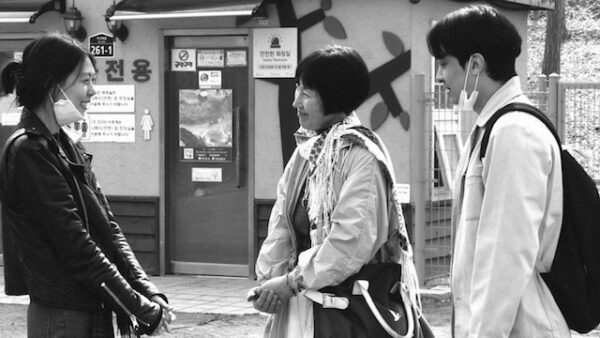
Still from “The Novelist’s Film” by Hong Sang-soo. The film was recently screened at The Museum of Fine Arts, Houston.
I sprinted down the parking garage stairway and weaved through the busy intersection. I had driven six hours, with three pee breaks and one car maintenance light, only to arrive at the Museum of Fine Arts, Houston five minutes late. I was there to attend a screening of one of South Korean director Hong Sang-soo’s latest films, The Novelist’s Film. I have been a fan of Hong since discovering him by chance in college, where my interactions with his work were always confined to a living room. And there I was, my first theatrical experience slipping through my fingers as I raced up the stairs next to another late patron around my age. We both found our seats in the dark, sweating and breathing heavily.
So, why would I drive six hours to see a movie? Especially at a time when the majority of movies come out on-demand at the same time as their theatrical release. It wasn’t because the last four movies by Hong Sang-soo are practically impossible to find, unless you’re some kind of film archivist with connections. And it wasn’t because I wanted to write this article and include all these details to show how much I had sacrificed (you could say I risked my life to see this movie). It was because what Hong Sang-soo creates with a simple camera and tripod set-up, and an even simpler plot, is something in limbo between theater and film, and should be experienced as a member of an audience. This is why I drove six hours to see a movie.

Still from “The Novelist’s Film” by Hong Sang-soo. The film was recently screened at The Museum of Fine Arts, Houston.
It’s been said that Hong writes many of his scenes the morning before shooting them; there is nothing sacred about the words within them. His script is merely a vessel for him and his cast to explore the intricacies of human interaction. In fact, the magic seems to be somehow slipped in between the lines of dialogue. For instance, early in the film a group of characters repeat a poem in sign language over and over, though none of them are deaf. It caught me off guard, but before I knew it, the interaction transformed from somewhat bizarre to truly enlightening. This film, like Hong’s others, forms each scene around a composition of characters within a static frame. There are no cutaways, no shot-reverse-shots, no close-ups. In doing so, The Novelist’s Film invites the audience to speculate, to lean in and try to catch the small details. The camera only cuts in order to move to a new conversation.
Perhaps I could say that The Novelist’s Film, or any other Hong film, is more like eavesdropping on a conversation than anything else. And the transparency with which Hong explores his own life only accentuates this feeling. He incorporates the details of his own relationships, faults, and artistic pursuits into his scripts. This could simply be his own form of personal therapy, but it inevitably leaves me engrossed in what seem to be raw, unfiltered feelings. The actors embrace the baggage of Hong’s experiences and shortcomings, as well as their own, in order to shape each film into a peephole view of their shared vulnerabilities.
The Novelist’s Film opens on a conversation between a novelist and her former colleague (that is, if you sprinted into the theater a few minutes late). Later, the novelist joins a film director and his wife on a walk. They run into a recently retired but young actress, and the novelist takes an instant liking to her. The film director questions the actress’s decision to leave the industry, which prompts the novelist to defend her. The novelist and the actress then decide to spend the day together, and the novelist convinces her that they should make a short film together, which actually plays at the end of The Novelist’s Film.
So, yes, the film is basically a series of conversations; old acquaintances rehashing the same buried disputes and strangers discovering companionship. But why not just make it a play? Because, if it was a play, it would be missing an essential detail that Hong captures behind the camera: micro expressions. The intimacy of the space between the characters and the audience, and a feeling of investigative viewing, means that interpretation is at the essence of one’s experience with this film. The actors aren’t there to tell the viewer how to feel, but to provide an ambiguous web of social emotions which the viewer can decipher using their own framework. Scenes may elicit a completely different reaction in each audience member.

Still from “The Novelist’s Film” by Hong Sang-soo. The film was recently screened at The Museum of Fine Arts, Houston.
I remember there was something special about hearing someone in the audience giggle at the same time as me. It wasn’t because of the dialogue or the premise of a scene, but a quiet reaction from a character in the background as they listened, really listened. Something that I thought only I caught. There were moments like this that the entire audience shared, too. Moments when it seemed like everyone in the theater let out a laugh of relief at the same time, realizing, suddenly, that we all felt something was off. It’s like finding yourself listening in on someone else’s conversation, and looking over at a stranger doing the same, and you both smile, realizing that the ridiculous nature of it all is actually more obvious than you thought.
With all that being said, the story is of least importance in a Hong film. His pursuit with The Novelist’s Film, which he clearly states in one of the novelist’s monologues, is to put two people together and capture a real connection between them; no “acting” required. It is in this pursuit that I think he failed. The issue is that the novelist, who is the driving force in the film, is a hypocritical character. The director, who continually prodded the retired actress about her wasted potential, was wrong to persuade the actress into shooting a film. Meanwhile, the novelist’s affectionate disposition toward the actress hid the fact that her intentions were the same as the director’s. Though I enjoyed many of the tender moments between these two characters, what was supposed to be a genuine connection played more like manipulation.
It could be that I’ve subconsciously become protective of Kim Min-hee, the actress in the film, since she has starred in nine of Hong’s films. But that’s my skepticism, my baggage, my failure. Regardless, it’s clear that the “plot” that Hong uses in order to wind his way to the grand finale of the film — the actual short film by the novelist — only taints his original pursuit. What begins as something pure between the novelist and actress morphs into a seemingly selfish artist-muse relationship.

Still from “The Novelist’s Film” by Hong Sang-soo. The film was recently screened at The Museum of Fine Arts, Houston.
I can’t necessarily rag on Hong for the issues I’ve mentioned, though, because they come from my own interpretation and could easily be inspired by his own complex feelings of “connection” with Kim Min-hee. However, it is in those final minutes, when the novelist’s short film plays, that Hong’s vision breaks down. The short is simple. The actress is making a bouquet with flowers she found, often looking straight into the camera; a sign that she is no longer acting. It’s supposed to be a moment for the audience to connect with Kim Min-hee as a person, not an actress, and share in Hong’s adoration of her; a reflection of the novelist’s sentiments. There were no words, no plot, no characters, no acting needed, but, for some reason, there was music. Music that signaled “feel something here.” Then, even more egregious, the film switched from black and white to color. Rather than feeling spontaneous and special, it felt manufactured — quite the opposite of what Hong intended.
So, after a long night of questioning my decision to make this trip to Houston, I got back in my car and began my long drive home in discontentment. I thought about the final scene of the film, and about all the other Hong films I had seen. And I thought about the other late patron who raced up the stairs next to me, and the knowing look we gave each other. That’s when I realized, it’s never been about the ending. Never with Hong Sang-soo. It’s about the moments that stick with you. Moments that you do feel a connection, even if it’s when you least expect it.
The Novelist’s Film is currently unavailable to stream. If interested, I suggest Hong Sang-soo’s 2015 film Right Now, Wrong Then, which is available to rent or buy.


